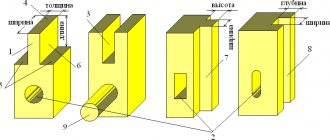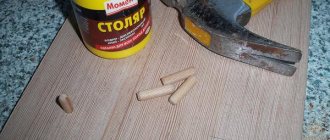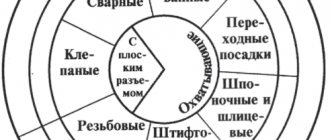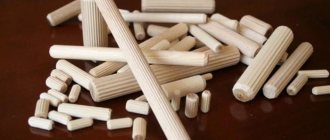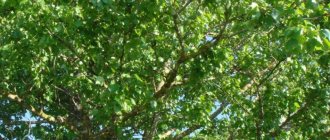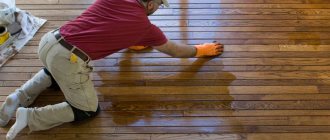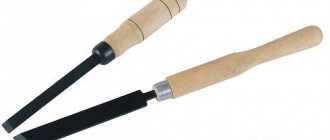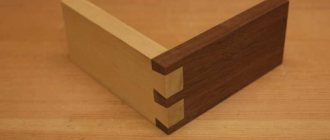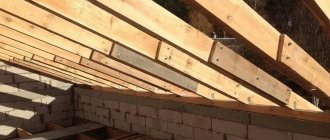The strength of the structure and its aesthetic appearance directly depend on the type of connection of all its components. Almost all types of timber - boards, beams or beams - are cut according to standard measurements, which is not always convenient in the construction industry. Therefore, to obtain the necessary parts from wood, builders use various types of connections using notches, which are made according to markings applied with special equipment or manually.
The initial component of the structure - the part - can be made from a single piece of wood material, or from bars jointed together. The joining of the components together forms a unit - a box, which represents the structural constituent elements. All components are connected to each other with iron staples, glue or carpentry. Carpentry joints of wood parts - knitting, can be divided into types depending on the area of application.
Types of connections:
- along the length - the wooden elements are attached to each other at their ends. The joining of the material is carried out by building up or splicing structural elements;
- along the edges - a kind of joining of several boards for rapid growth of the width of the structural element;
- connecting corner end pieces of wood, brought together at different angles, to form a large number of useful components of building elements and frame parts for furniture;
- angular median joints are the joining of two components, of which one part of the part is adjacent with its end to the middle of the other or, to form shields in it, runs along its width;
- box corner - box knitting of wide boards. Wooden joints without nails are used in assembling various types of boxes or crates.
Initial information
Connection categories
All connections (in carpentry they are called ties) of wooden parts according to their area of application can be divided into three categories (foreign version of the classification):
- box;
- frame (frame);
- for joining/merging.
Box joints are used, for example, in the manufacture of drawers and cabinets, frame joints are used in window frames and doors, and joining/splicing is used to obtain parts of increased width/length.
Many connections can be used in different categories, for example, butt connections are used in all three categories.
Preparation of material
Even planed lumber may need some preparation.
- Cut the material with a margin of width and thickness for further planing. Don't cut the length yet.
- Choose the best quality surface - the front side. Plane it along its entire length. Check with a straight edge. After final alignment, make a mark for the front side with a pencil.
- Plane the front - clean - edge. Check with a straight edge and a square against the front side. Use planing to smooth out any warping. Mark the clean edge.
- Using a thicknesser, mark the required thickness along all edges of the part contour. Plan to this risk. Check with a straight edge.
- Repeat for width.
- Now mark the length and the actual connections. Mark from the front side to the clean edge.
Marking lumber
Be careful when marking lumber. Make sufficient allowances for the width of cuts, planing thickness and connections.
Take all readings from the front side and the clean edge, on which place the appropriate marks. In frame and cabinet designs, these marks should face inward to improve manufacturing accuracy. To make sorting and assembling easier, number the parts on the front side as they are manufactured, to indicate, for example, that side 1 connects to end 1.
When marking identical parts, carefully align them and make markings on all workpieces at once. This will ensure the markup is identical. When marking profile elements, keep in mind that there may be “right” and “left” parts.
Cabinets
- Rice. 2 - cabinet made entirely of wooden joints. Dowel loops are used. The doors are held together with juniper branches cut into the shape of a nail. The dowel holds the joints together.
- Rice. 31 and Fig. 32 - Door tension and wood nails that hold the sliding dovetail bracket that holds the doors together.
- Rice. 33—juniper pegs, cut and wedged to hold doors.
- Rice. 34 - wardrobe.
- Rice. 35 - kitchen cabinet.
Butt joints
These are the simplest of carpentry joints. They can fall into all three categories of compounds.
Assembly
The butt joint can be strengthened with nails driven in at an angle.
Drive the nails in randomly. Trim the ends of the two pieces evenly and connect them. Secure with nails or screws. Before this, you can apply glue to the parts to strengthen the fixation. Butt joints in frame structures can be reinforced with a steel plate or a wavy key on the outside, or with a wooden block secured from the inside.
Chairs
Assembling a chair is perhaps the most difficult task for woodworking - the chair must support a lot of weight even with a normal person.
- Rice. 36 - rocking chair made of walnut and alder.
- Rice. 37 is a work chair made of oak and cherry. The back swivels on two spikes, allowing you to sit upright for typing or recline at a steeper angle.
- Rice. 38 - Phillipine Mahogany Cantilever Dining Chair.
- Rice. 39 and Fig. 40 - chair details.
Pin/dowel connections
Wooden dowels - today they are increasingly called dowels - can be used to strengthen the connection. These insertable round tenons increase shear (shear) strength and, due to the adhesive, secure the assembly more reliably. Dowel joints can be used as frame joints (furniture), box joints (cabinets) or for joining/splicing (panels).
Assembling the dowel connection
1. Carefully cut out all components to the exact dimensions. Mark the position of the crossbar on the face and clean edge of the post.
2. Mark center lines for the dowels at the end of the crossbar. The distance from each end should be at least half the thickness of the material. A wide crossbar may require more than two dowels.
Mark the center lines for the dowels at the end of the crossbar and use the square to transfer them to the rack.
3. Lay the rack and bar face up. Using the square, transfer the center lines to the stand. Number and label all connections if there is more than one pair of posts and crossbars.
4. Transfer these markings to the clean edge of the post and the ends of the crossbar.
5. From the front side, use a thicknesser to draw a line in the center of the material, crossing the marking lines. This will mark the centers of the holes for the dowels.
Use a thicknesser to draw a center line, crossing the marking lines, which will show the centers of the holes for the dowels.
6. Using an electric drill with a twist drill bit or a hand drill with a spade bit, drill holes in all the parts. The drill must have a center point and scorers. The hole across the fibers should have a depth of approximately 2.5 times the diameter of the dowel, and the hole in the end should have a depth equal to approximately 3 times the diameter. For each hole, make an allowance of 2 mm; the dowel should not reach the bottom by this distance.
7. Use a countersink to remove excess fibers from the top of the holes. This will also make it easier to install the dowel and create space for the adhesive to secure the joint.
Nageli
The dowel must have a longitudinal groove (now standard dowels are made with longitudinal ribs), along which excess glue will be removed when assembling the joint. If the dowel does not have a groove, then plan it flat on one side, which will give the same result. The ends should be chamfered to facilitate assembly and prevent damage to the hole by the dowel. And here, if the dowels do not have a chamfer, make it with a file or grind the edges of their ends.
Using centers to mark dowels
Mark and drill the crossbars. Insert special dowel centers into the holes for the dowels. Align the crossbar with the post markings and press the pieces together. The points of the centers will make marks on the stand. Drill holes through them. As an alternative, you can make a template from a wooden block, drill holes in it, fix the template on the part and drill holes for dowels through the holes in it.
Using a conductor for a dowel connection
A metal jig for dowel connections greatly facilitates marking and drilling holes for dowels. In box joints, the jig can be used at the ends, but it will not work on the faces of wide panels.
conductor for pin connections
1. Mark center lines on the front side of the material where the dowel holes should be. Select a suitable drill guide and insert it into the jig.
2. Align the alignment marks on the side of the jig and secure the movable support of the guide bushing.
3. Install the jig onto the part. Align the centering notch with the center line of the dowel hole. Tighten.
4. Install a drill depth stop on the drill in the required location.
Rally
To obtain a wider wooden part, you can use dowels to connect two parts of the same thickness along the edge. Place two boards with their wide sides together, align their ends exactly, and clamp the pair in a vice. On the clean edge, draw perpendicular lines to indicate the center lines of each dowel. In the middle of the edge of each board, use a thicknesser to score marks across each previously marked center line. The intersection points will be the centers of the holes for the dowels.
The nail joint is neat and durable.
Making wooden latches
Rice. 28 - door latches. Simple door latches can be made with just two dowels. A dowel from 19 to 25 mm is inserted through the door. A 6mm dowel is drilled into the handle pins to make the latch.
Rice. 29 - the door is closed and latched into a groove cut into the block in the door frame.
Rice. 29 and fig. 30 - spring retainer , which uses thin oak as a spring. A wooden door handle on one side and a lever on the other activate the latch.
Notch / mortise connections
A notch, mortise or groove connection is called a corner or median connection, when the end of one part is attached to the layer and another part. It is based on a butt joint with an end cut made in the face. Used in frame (house frames) or box (cabinets) connections.
Types of jack/punch connections
The main types of notch joints are the t-notch in the dark/semi-dark (often this term is replaced by the term “flush/semi-dark”), which looks like a butt joint, but is stronger, the corner notch (corner connection) in the quarter and the corner notch in the dark/semi-dark. A corner notch into a rebate and a corner notch into a rebate with darkness/semi-darkness are made in the same way, but the rebate is made deeper - two-thirds of the material is selected.
Carrying out cutting
1. Mark a groove on the front side of the material. The distance between the two lines is equal to the thickness of the second part. Continue the lines to both edges.
2. Using a thickness gauge, mark the depth of the groove between the marking lines on the edges. The depth is usually made from one quarter to one third of the thickness of the part. Mark the waste portion of the material.
3. Use a C-shaped clamp to securely fasten the part. Saw the shoulders on the outgoing side of the marking lines to the required depth. If the groove is wide, make additional cuts in the waste to make it easier to remove the material with a chisel.
Saw close to the marking line on the waste side, making intermediate cuts with a wide groove.
4. Using a chisel on both sides, remove excess material and check that the bottom is even. You can use a primer to level the bottom.
Use a chisel to remove waste, working from both sides, and level the bottom of the groove.
5. Check the fit; if the part fits too tightly, it may need to be trimmed. Check for squareness.
6. The notch connection can be strengthened in one of the following ways or a combination of them:
- gluing and clamping until the glue sets;
- screwing with screws through the face of the outer part;
- nailing at an angle through the face of the outer part;
- Nailing obliquely across a corner.
The notch connection is quite strong
Stools
- Rice. 41, 42 and 5 are stools I made using mostly mortise pins and tenon joints to secure the legs.
- Rice. The 43 is one of the easiest stool designs you can make. This is an old colonial American design. The seat is cut from a 450mm diameter log that has been split in half. I used dried juniper branches for the legs. After more than 20 years, the legs are still firmly in the grooves.
Another way to attach the legs is to use a devil wedge. It got its name because once it is blocked, the connection is almost impossible to disconnect (see Fig. 44).
Groove and side tongue joints
This is a combination of a quarter cut and a rebate cut. It is used in the manufacture of furniture and the installation of slopes for window openings.
Making a connection
1. Make the ends perpendicular to the longitudinal axes of both parts. Mark the shoulder on one part, measuring the thickness of the material from the end. Continue marking on both edges and the front side.
2. Mark the second shoulder from the end side; it should be at a distance of one third of the thickness of the material. Continue on both edges.
3. Using a thickness gauge, mark the depth of the groove (one-third of the thickness of the material) on the edges between the shoulder lines.
4. Using a hacksaw, saw through the shoulders to the thickness line. Remove waste with a chisel and check the alignment.
5. Using a thicknesser with the same setting, mark a line on the back side and on the edges of the second part.
Adviсe:
- Mortise and tongue-and-groove joints can be easily made using a router and a suitable guide - either for the groove only, or for both the groove and the tongue. Recommendations for proper operation of the router, see p. 35.
- If the comb fits into the groove too tightly, trim the face (smooth) side of the comb or sand it with sandpaper.
6. From the front side, use a thicknesser to mark the edges towards the end and at the end itself. Saw along the lines of the planer with a hacksaw. Don't cut too deep as this will weaken the joint.
7. Using a chisel from the end, remove the waste. Check fit and adjust if necessary.
Electrical tools
Rice. 8 – power tools that are very useful:
- A - The sander is used for final sanding.
- B - A battery powered jigsaw is used to cut mortise and curved chair legs.
- C - grinding machine for rough smoothing.
- D - circular saw for making straight cuts, powered by an 18 V battery.
- E - cordless drill for making holes of all sizes.
- F - a hand router (not in the photo) works well when cutting dovetail joints.
Half-tree connections
Half-timber joints are frame joints that are used to join parts together face to face or along an edge. The joint is made by removing the same amount of material from each piece so that they fit flush with each other.
Types of half-tree connections
There are six main types of half-timber joints: transverse, corner, flush, miter, dovetail and splice.
- Half-tree cross connection . Allows you to connect two intersecting parts without cutting one in half. It is performed in the same way as a notch connection with half the material removed from each part. The width corresponds to the width of the part being intersected. The material is removed from the bottom of one part and from the top of the second.
- Half-tree corner connection . Made for the end connection of two parts at an angle of 90°. A half-wood T-joint is similar to a corner joint, but a groove is selected on one part, and a rebate (overlay) on the second. It can be done in the dark.
- Half-tree miter joint . Used when a decorative overlay is made on the upper front side. The bevel of the face of the connection corresponds to the rotation of the cover plate.
- Half-tree dovetail connection . A dovetail-shaped tenon is cut out of this connection (on both or both sides). The connection is disconnected only if the upper part is lifted upward from the groove of the lower one. The slope is usually 1:6.
- Half-tree splicing .
This connection is used to connect parts with their ends in one straight line using an overlay. The length of the selected part of the material (overlay) is equal to the width of the part. For sufficient strength, the connection requires reinforcement. Connections in wood are similar to a cut/inset .
Making a half-tree corner connection
1. Align the ends of both parts. On the top side of one of the parts, draw a line perpendicular to the edges, stepping back from the end to the width of the second part. Repeat on the underside of the second piece.
2. Set the thicknesser to half the thickness of the parts and draw a line on the ends and edges of both parts. Mark the waste on the top side of one piece and the bottom side of the other piece.
3. Clamp the part in a vice at an angle of 45° (faces vertical). Saw carefully along the grain, close to the thickness line on the waste side, until the saw is diagonal. Turn the piece over and continue cutting carefully, gradually lifting the saw handle until the saw is aligned with the shoulder line on both edges.
4. Remove the part from the vice and place it on the surface. Press it tightly to the tsulaga and clamp it with a clamp.
5. Saw the shoulder to the previously made cut and remove the waste. Use a chisel to smooth out any unevenness in the sample. Check that the cut is neat.
6. Repeat the process on the second piece.
7. Check the fit of the parts and, if necessary, level them with a chisel. The connection must be rectangular, flush, without gaps or backlash.
8. The connection can be strengthened with nails, screws, and glue.
Making simple wooden hinges
Rice. 22 - door hinges . A very beautiful cabinet and full-size door hinges can be easily made using wooden dowels. They can be partially or completely hidden, providing a very clean design in cabinet doors.
The dowel is inserted into holes drilled in the top and bottom of the door. The pins then fit into holes drilled into the top of the door frame and the bottom of the door sill.
Rice. 23 - on pins. Shown is the bottom of a cabinet door with a hidden top pin and an access hole used to install the bottom pin. The bottom pin passes through a plastic washer that serves as a bearing and can be cut from any thin plastic. The pins were rubbed with beeswax to reduce friction, but paraffin candles also work.
Rice. 24 - book loops. I made a photo album with entirely wooden hinges. Two dowels rotate at each hinge to allow the book to open completely. Leather and rope loops were also used to attach pages. Rice. 25 shows the hinge details.
Rice. 26 - The front door has 25mm top and bottom dowels, and my closet doors have 6mm dowels. None of the dowels showed significant wear after more than twenty years of daily use. For larger doors like the front door, I mounted it on an oak bearing.
Miter corner connections
Miter corner joints are made by bevelling the ends and hide the end grain and are aesthetically more consistent with the angular rotation of the decorative trim.
Types of miter corner joints
To bevel the ends in a miter joint, the angle at which the parts meet is divided in half. In a traditional connection, this angle is 90°, so each end is cut at 45°, but the angle can be either obtuse or acute. In uneven miter corner joints, parts with different widths are connected.
Performing miter joints
1. Mark the length of the pieces, keeping in mind that it should be measured along the long side, since the bevel will reduce the length inside the corner.
2. Having decided on the length, mark a line at 45° - on the edge or on the face, depending on where the bevel will be cut.
3. Using a combination square, transfer the markings to all sides of the part.
4. When cutting by hand, use a miter box and a hacksaw or hand miter saw. Press the piece firmly against the back of the miter box - if it moves, the bevel will be uneven and the joint will not fit well. If you are simply sawing by hand, watch the process so as not to deviate from the marking lines on all sides of the part. A power miter saw, if you have one, will make a very neat bevel.
5. Place the two pieces together and check the fit. You can correct it by trimming the bevel surface with a plane. Firmly fix the part and work with a sharp plane, setting the knife overhang to a small extent.
6. The connection should be nailed through both parts. To do this, first place the parts on the surface and drive nails into the outer side of the bevel so that their tips slightly appear from the bevels.
Place nails in both parts so that the tips protrude slightly from the surface of the bevel.
7. Apply glue and press the joint tightly so that one part protrudes slightly and overlaps the other. First, drive nails into the protruding part. Under the blows of the hammer when hammering nails, the part will move slightly. The surfaces must be level. Nail the other side of the joint and countersink the nail heads. Check for squareness.
Drive the nails into the protruding part first and the hammer will move the joint into position.
8. If due to unevenness of the workmanship there is a small gap, smooth the connection on both sides with the round blade of a screwdriver. This will move the fibers, which will close the gap. If the gap is too large, you will either have to redo the connection or seal the gap with putty.
9. To strengthen the corner joint, you can glue a wooden block inside the corner if it is not visible. If appearance is important, the connection can be made using a tenon or secured with veneer dowels. Dowels or lamellas (standard flat plug-in tenons) can be used inside flat joints.
Basic workflow requirements
Before we begin to consider specific options for carrying out work, it is necessary to understand what factors will ensure that we obtain the expected result:
| Material quality | Everything is simple here: it is impossible to make durable structures from low-quality wood, especially with regard to joints; if they have knots, damage from woodworms, mold and other problems, then there can be no question of any reliability and durability. Select the best elements so as not to waste effort and money |
| Humidity | Another most important parameter that should always be taken into account. Only dry elements are suitable for work, since high humidity, firstly, reduces strength, secondly, reduces the adhesion of the adhesive composition when using it, and thirdly, after completion of the work, no one will guarantee that in a week or month the structure it won't move or it won't crack |
| Connection Loads | The choice of one or another connection option largely depends on this indicator; the greater the load, the higher the requirements for the quality of the connection and the more complex the process. Therefore, decide in advance which option will be used to ensure a good result. |
| Using a quality tool | A lot also depends on this, especially when it comes to complex options when the connection is cut with special devices. They must ensure maximum cutting quality and maximum joining accuracy, since reliability largely depends on this |
Important! Remember one simple rule that experts always use: to get the best result, the parameters of the elements being joined must be similar; in other words, the same type of wood must be used.
The simplest example of structures where width jointing is used is a tongue-and-groove floorboard
Miter splicing and cutting connection
A miter splice connects the ends of parts that are located on the same straight line, and a rip splice is used when it is necessary to connect two profile parts at an angle to each other.
Miter splicing
When miter splicing, the parts are connected with identical bevels at the ends in such a way that the same thickness of the parts remains unchanged.
Connection with cutter
A connection with a cut (with a cut, with a fit) is used when it is necessary to connect two parts with a profile in a corner, for example, two plinths or cornices. If the part moves during the process of fastening it, the gap will be less noticeable than with a miter joint.
1. Secure the first baseboard in place. Move the second plinth located along the wall close to it.
Clamp the first baseboard in place and press the second baseboard against it, lining it up with the wall.
2. Run a small wooden block with a pencil pressed to it along the profile surface of the fixed baseboard. The pencil will leave a marking line on the plinth being marked.
Using a block with a pencil pressed to it, with the tip pointed at the second plinth, draw along the relief of the first plinth, and the pencil will mark the cut line.
3. Cut along the marking line. Check the fit and adjust if necessary.
Complex profiles
Place the first plinth in place and, placing the second plinth in the miter box, make a bevel on it. The line formed by the profile side and the bevel will show the required shape. Cut along this line with a jigsaw.
Scheme of the truss structure
Along the perimeter of the wall, a mauerlat is laid - a beam, which takes on part of the load-bearing function, evenly distributing it onto the load-bearing walls. The bases of all structural elements will be placed on it.
Purlins are laid across the building; the same purlins will serve as support for the rafter legs in the middle of the structure.
They raise trusses, pre-installed on the ground, that will hold the ridge and attach them to the mauerlat.
They install supports for the ridge, lay the ridge and attach diagonal, intermediate rafters to it.
Strengthen the structure with the help of struts, supports and crossbars.
Racks for rafters Source domdkm.ru
Rafters are laid on the structure, taking into account the design distance between the individual beams. The ends of the legs rest against the mauerlat, and the top is sawed off and connected with metal fasteners at the beveled corners. Waterproofing, insulation and roofing are laid on the finished base.
The correct location and methods of connecting the beams guarantee stability when laying insulation and roofing. Further operation of the facility largely depends on accurate design and correctly selected lumber.
It is preferable to lay spliced rafters when installing steep roof slopes, where atmospheric loads are several times lower than on flat slopes. Flat slopes in winter are loaded under the influence of snow, which puts pressure on the lumber under the roof.
Lug connections
Lug joints are used when there is a need to connect intersecting parts located “On Edge”, either at the corner or in the middle (for example, the corner of a window sash or where a table leg meets a crossbar).
Types of lug connections
The most common types of eyelet connections are corner and T-shaped (T-shaped). For strength, the connection must be glued, but it can be strengthened with a dowel.
Making an eyelet connection
1. Make the markings in the same way as for a tenon-to-socket joint, but divide the thickness of the material by three to determine one-third. Mark the waste on both parts. On one part you will need to select the middle. This groove is called an eye. On the second part, both side parts of the material are removed, and the remaining middle part is called a tenon.
2. Saw along the grain to the shoulder line along the marking lines on the waste side. Use a hacksaw to cut out the shoulders, and you will get a tenon.
3. Working from both sides, remove material from the eye with a chisel/mortise chisel or jigsaw.
4. Check the fit and adjust with a chisel if necessary. Apply glue to the joint surfaces. Check for squareness. Using a C-clamp, clamp the joint while the glue hardens.
List of fasteners required for building a house
A frame building resembles a construction set that needs to be assembled correctly. But unlike children's educational games, the constructed building must be strong and durable, so the choice of fasteners must be approached responsibly.
Throughout the entire period of construction of the cottage, the following elements will be needed for fastening:
- corner and straight brackets;
- plates (flat and corners);
- beam holders;
- sliding and nail plates;
- mounting tape;
- corner connectors;
- drive-in fasteners for racks;
- anchor and adjusting connections.
When building a frame cottage, it is necessary to take into account all the nuances of construction so that the building turns out strong and reliable. Therefore, you need to use all the necessary types of fasteners to connect the main and auxiliary units. Do not forget about treating metal parts with materials that prevent corrosion and condensation.
Tenon to socket connection
Tenon-to-socket joints, or simply tenon joints, are used when two parts are joined at an angle or intersection. It is probably the strongest of all frame joints in joinery and is used in the making of doors, window frames and furniture.
Types of tenon-to-socket connections
The two main types of tenon joints are the usual tenon-to-socket joint and the stepped tenon-to-socket joint (semi-dark). The tenon and socket make up approximately two-thirds of the width of the material. The socket is widened on one side of the groove (semi-dark), and a tenon step is inserted into it from its corresponding side. Semi-darkness helps prevent the thorn from being turned out of the socket.
Conventional tenon-to-socket connection
1. Determine the joint position on both pieces and mark all sides of the material. The marking shows the width of the intersecting part. The tenon will be at the end of the crossbar, and the socket will go through the post. The tenon should have a small allowance in length for further stripping of the joint.
2. Select a chisel that is as close in size as possible to a third of the thickness of the material. Set the thicknesser to the size of the chisel and mark the socket in the middle of the post between the previously marked marking lines. Work from the front side. If desired, you can set the thicknesser solution to a third of the thickness of the material and work with it on both sides.
H. In the same way, mark the tenon on the end and both sides until you mark the shoulders on the crossbar.
4. In a vice, clamp an auxiliary support in the form of a piece of wood high enough so that you can attach the stand to it, turned “on edge.” Secure the stand to the support, placing the clamp next to the marking of the socket.
5. Cut out a nest with a chisel, making an allowance inwards of about 3 mm from each end so as not to damage the edges when removing waste. Hold the chisel level, keeping its edge parallel to the plane of the counter. Make the first cut strictly vertically, placing the sharpening bevel towards the middle of the socket. Repeat from the other end.
6. Make several intermediate cuts, holding the chisel at a slight angle and with the sharpening bevel down. Select a retreat, using the chisel as a lever. Having gone deeper by 5 mm, make more cuts and select a waste. Continue until about halfway thick. Turn the piece over and work the same way on the other side.
7. After removing the main part of the waste, clean out the nest and cut off the previously left allowance to the marking lines on each side.
8. Cut a tenon along the fibers, running a hacksaw along the marking line on the waste side, and cut out the shoulders.
9. Check fit and adjust if necessary. The shoulders of the tenon should fit neatly into the post, the connection should be perpendicular and have no play.
10. To secure, you can insert wedges on both sides of the tenon. The gap for this is made in the socket. Working with a chisel from the outside of the socket, widen it to about two-thirds of the depth with a 1:8 slope. The wedges are made with the same bias.
11. Apply glue and squeeze tightly. Check for squareness. Apply glue to the wedges and drive them into place. Saw off the tenon allowance and remove excess glue.
Other tenon joints
Tenon joints for window frames and doors are somewhat different from tenon joints in semi-darkness, although the technique is the same. Inside there is a fold and/or lining for glass or panel (panel). When making a tenon-to-socket connection on a part with a rebate, make the plane of the tenon in line with the edge of the rebate. One of the shoulders of the crossbar is made longer (to the depth of the fold), and the second is made shorter so as not to block the fold.
Tenon joints for parts with overlays have a shoulder that is cut to match the profile of the overlay. An alternative is to remove the trim from the edge of the socket and make a bevel or cut to match the mating piece. Other types of tenon-to-socket connections:
- Side tenon - in the manufacture of doors.
- A hidden beveled tenon in semi-darkness (with a beveled step) - to hide the tenon.
- A tenon in the dark (tenon steps on both sides) - for relatively wide parts, such as the bottom trim (bar) of a door.
All these connections can be through, or they can be blind, when the end of the tenon is not visible from the back of the rack. They can be strengthened with wedges or dowels.
Screwless fittings
The main holding element when attaching screwless fittings is the dowel element, cast integrally with its body. The dowel has the shape of a sleeve with pointed annular or semi-circular projections.
The fittings are installed by pressing dowels into pre-drilled holes using special equipment. Screwless fittings are technologically advanced. Provides sufficient strength.
Construction nails
The design of construction nails with a flat head corresponds to GOST 4028-63 and is shown in Figure 8.
Symbol of nails with a flat head with a core diameter of 1.2 mm and a length of 25 mm: nails P 1.2 × 25 GOST 4028-63.
Upholstery staple
The general view of the brackets is shown in Figure 9.
Screws with a semicircular head (GOST 1144-80)
Symbol of the screw: screw 3 × 20 GOST 1144-80. The general view of the screws is shown in Figure 10.
| Rice. 8. Construction nail | Rice. 9. Brace | Rice. 10. Screw |
Hex head screws (GOST 11473-75)
The general view of screws with a hexagonal head is shown in Figure 11. Symbol: screw 4 × 50 GOST 11473-75.
Screws with countersunk head (GOST 1145-80)
A general view of screws with a countersunk head is shown in Figure 12.
Symbol: screw 3 × 20 GOST 1145-80.
Bolt with an enlarged semicircular head and a mustache (GOST 7801-81)
The general view of bolts with an enlarged semicircular head and mustache is shown in Figure 13. Symbol: bolt M6 × 40 GOST 7801-81.
Screws with a semi-countersunk head (GOST 1146-80)
The dimensions of screws with a semi-countersunk head are shown in Figure 14. Symbol: screw 3 × 20 GOST 1146-80.
| Rice. 11. Hex head screw | Rice. 12. Countersunk screw |
| Rice. 13. Bolt with an enlarged semicircular head and a mustache | Rice. 14. Screw with a semi-countersunk head |
Hex head bolts (GOST 7798-70)
The main type of hex head bolts is shown in Figure 15. Symbol: bolt M 12 × 60 GOST 7798-70.
Hex nuts (GOST 5927-70) are shown in Figure 16. Symbol: M8 nut (GOST 5927-70), where H is the height of the nut; M – thread diameter; S – turnkey size.
Rice. 15. Hex bolt
| Rice. 16. Hex nut | Rice. 17. Puck |
Washers (GOST 11371-68)
The main type of washers is shown in Figure 17.
Symbol: washer 12 (GOST 11371-68).
Rally
Wide, high quality timber is becoming increasingly difficult to find and very expensive. In addition, such wide boards are subject to very large shrinkage deformations, which makes working with them difficult. To join narrow boards along the edges into wide panels for tabletops or workbench covers, they use bonding.
Preparation
Before starting the bonding itself, you must do the following:
- If possible, select radial sawn boards. They are less susceptible to shrinkage deformations than tangential sawn timber. If tangentially sawn boards are used, then place their core side alternately in one direction and the other.
- Try not to combine materials with different sawing methods into one panel.
- Never join boards of different types of wood unless they have been properly dried. They will shrink and crack differently.
- If possible, place the boards with the grain in the same direction.
- Be sure to cut the material to size before joining.
- Use only good quality glue.
- If the wood will be polished, select the texture or color.
Rallying on a smooth fugue
1. Lay out all the boards face up. To facilitate subsequent assembly, mark the edges with a continuous pencil line drawn along the joints at an angle.
2. Plane straight edges and check fit to appropriate adjacent boards. Align the ends or pencil lines each time.
3. Make sure there are no gaps and that the entire surface is flat. If you squeeze the gap with a clamp or fill it with putty, the connection will subsequently crack.
4. When planing short pieces, clamp two in a vise, right sides together, and plane both edges at the same time. There is no need to maintain the squareness of the edges, since when joining they will mutually compensate for their possible tilt.
5. Prepare as for a butt joint and apply glue. Using squeezing and rubbing, connect the two surfaces, squeezing out excess glue and helping the surfaces “suck” to each other.
Other ways to rally
Other bonding connections with different strengths are prepared in the same way. These include:
- with dowels (dowels);
- in tongue and groove;
- at a quarter.
Creating a sliding dovetail
Rice. 16:
- A - I mark the dovetail on the board so that it tapers in both directions.
- B - I cut the dovetail by tilting the saw at an angle of 3 to 5 degrees. Then I sand and smooth the edges until they are straight and smooth.
- C - I cut out the dovetail groove.
- D - I use a chisel to hollow out a groove.
Rice. 17 shows the finished sliding dovetail.
Figures 18 and 19 show how a dovetail was used to create a leg on a work chair that compresses as weight increases.
Gluing and fixing with clamps
Gluing and fixing glued parts is an important part of woodworking, without which many products will lose strength.
Adhesives
The glue strengthens the connection, holding the parts together so that they cannot be easily pulled apart. When working with adhesives, be sure to wear protective gloves and follow the safety instructions on the packaging. Clean the product from excess glue before it sets, as it can dull the plane knife and clog the abrasive sandpaper.
PVA (polyvinyl acetate)
PVA glue is a universal wood glue. While still wet, it can be wiped off with a cloth dampened with water. It perfectly glues loose surfaces, does not require long-term fixation for setting and sets in about an hour. PVA gives a fairly strong connection and sticks to almost any porous surface. Provides a permanent connection but is not heat or moisture resistant. Apply with a brush, or for large surfaces, dilute with water and apply with a paint roller. Since PVA glue is water-based, it shrinks when it sets.
Contact glue
Contact adhesive bonds immediately after application and joining of parts. Apply it to both surfaces and when the glue is dry to the touch, press them together. It is used for laminate or veneer to chipboard. No fixation required. Can be cleaned with solvent. Contact adhesive is flammable. Handle it in a well-ventilated area to reduce fumes. Not recommended for outdoor use as it is not moisture or heat resistant.
Epoxy adhesive
Epoxy glue is the strongest of the adhesives used in woodworking, and the most expensive. This is a two-component resin-based adhesive that does not shrink when set and softens when heated and does not creep under load. It is water-resistant and bonds to almost all materials, both porous and smooth, with the exception of thermoplastics, such as polyvinyl chloride (PVC) or plexiglass (plexiglass). Suitable for outdoor use. In an uncured form, it can be removed with a solvent.
Hot melt adhesive
Hot melt, solventless adhesive will stick to almost anything, including many plastics. Typically sold in the form of glue sticks that are inserted into a special electric glue gun. Apply glue, connect the surfaces and compress for 30 seconds. No fixation required. Can be cleaned with solvents.
Fixation clips
Clamps come in a variety of designs and sizes, most of which are called clamps, but usually only a couple of varieties are needed. Be sure to place a piece of scrap wood between the clamp and the work to avoid indentations from the applied pressure.
Gluing and fixation technique
Before gluing, be sure to assemble the product “dry” - without glue. Secure as necessary to check connections and dimensions. If everything is fine, disassemble the product, arranging the parts in a convenient order. Mark the areas to be glued and prepare clamps with jaws/stops set at the required distance.
Frame assembly
Using a brush, spread the glue evenly onto all surfaces to be glued and quickly assemble the product. Remove excess glue and secure the assembly with clamps. Apply even pressure to compress the joints. The clamps must be perpendicular and parallel to the surfaces of the product.
Place the clamps as close to the connection as possible. Check the parallelism of the crossbars and align if necessary. Measure the diagonals - if they are the same, then the rectangularity of the product is maintained. If not, then a light but sharp blow to one end of the post can straighten the shape. Adjust the clamps if necessary.
If the frame does not lie flat on a flat surface, tap the protruding areas with a mallet through a block of wood as a spacer. If this does not help, you may need to loosen the clamps or use clamps to secure a block of wood across the frame.
Briefly about the main thing
Splicing rafters provides significant savings in construction wood. There will be a minimum of wood waste left on the construction site.
There are several practical options for splicing rafter legs, each of which can be used during the construction of a house:
- For boards: overlap or double splice method;
- For a log house: direct joint or oblique joint.
When installing a rafter system, it is important to remember that the connection with fasteners should not weigh down the elements so much as to become problematic for the overall weight of the structure under the roof.
Proper rafting provides the same load resistance as solid timber.
Manufacturing of free-standing shelves and racks for spices
Rice. 53b - plans for creating convenient bookshelves that can be easily disassembled for transportation. They are made from standard lumber measuring 50x300 mm and dowels 19 and 6 mm.
- Step A is cutting the lumber to length. Make sure the ends of the shelves are cut square as this ensures diagonal strength for the shelves.
- Step B - Drill 20mm holes in the ends of the shelves and two posts.
- Step C - Install and secure the long tenon dowels using 6mm dowels drilled to cross them.
- Step D - Drill 6mm holes and cut the pins into a wedge shape (see Step 3).
- Step E - Assemble the shelves.
- Step F - Attach the shelf to the wall.
Rice. 4 — racks for spices.
- Spice rack with shelves held at sides by wedge mortise and tenon joints. This basic design can be scaled to make shelves of any size.
- The spice containers were made from aspen branches that were drilled using a 25mm feather drill and then coated with melted beeswax to seal the interior surfaces. Then the plugs were made.
